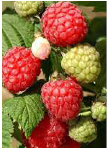 Loading... Please wait...
Loading... Please wait...- Ph/Fax:(08) 9767 3069
- My Account
- Order Status
- Wish Lists
- Gift Certificates
- View Cart
- Home
- Welcome to our Online Store
- Monthly Garden Tips
-
Growing Information
- Raspberries
- Asparagus
- Alstromeria - Peruvian Lily
- Anemones/Ranunculi
- Babiana
- Baby Gladiolus
- Belladonna Lilly (Easter Lily)
- Bluebells/Scillas
- Chincherinchee (Arab Eyes)
- Daffodils/Erlicheer
- Growing Daylilies
- Dutch Crocus
- Grow Dutch Iris
- Dwarf Iris - Reticulata
- Freesias
- Fritillaria
- Gladiolus
- Grape Hyacinths
- Hippeastrums
- Hyacinths
- Lachenalia - Soldier Boys
- Liliums
- Lily of the Valley
- Lycoris - Golden Spider Lily
- Nerines
- Peacock Iris
- Snowflakes/Snowdrops
- Rhubarb
- Triteleia
- Tulips
- Fundraiser
- Location Map
- About Us
- How to Order
Varieties
Our Newsletter
- Home
- Growing Information
- Raspberries
Raspberries

SITUATION: Raspberries grow best in cool to cold climates and like a rich, well drained soil. Generous quantities of organic manure or complete fertiliser should be added to the soil before planting.
TIME OF PLANTING: During winter months when plants are dormant. Space plants 50 cm apart
SUPPORTING THE PLANTS: Although not entirely necessary, this is recommended to make harvesting easier. Canes can be tied to a single wire trellis about 100-120 cm above the ground or otherwise grown and supported along a fence.
PRUNING: Summer Fruiting varieties: In winter tip prune the one year old canes by cutting 10 cm from the tips. This encourages laterals to form in the spring which will later bear the coming crop. New suckers that appear in the following spring should be cut off leaving no more than 8-10 of the strongest shoots per clump. These are best tied separately from the fruiting canes to make harvesting and pruning easier. When harvesting is completed, canes that have borne fruit (2 year old wood) should be cut off at ground level. The one year old wood (primocanes) should be tip pruned and are then left to provide the next season’s crop.
Autumn fruiting varieties can be treated as annuals and cut back to ground level in late autumn. New shoots that appear in spring should be thinned out to about 8-10 per clump. These will produce fruit the following autumn.
GENERAL CARE: Water well during warmer months. Pests such as aphids, thrips and caterpillars can be controlled with a pyrethrum based insecticide. Should any fungal diseases affect the plants, spray with a suitable fungicide. When fruit is ripening watch for invading birds.
